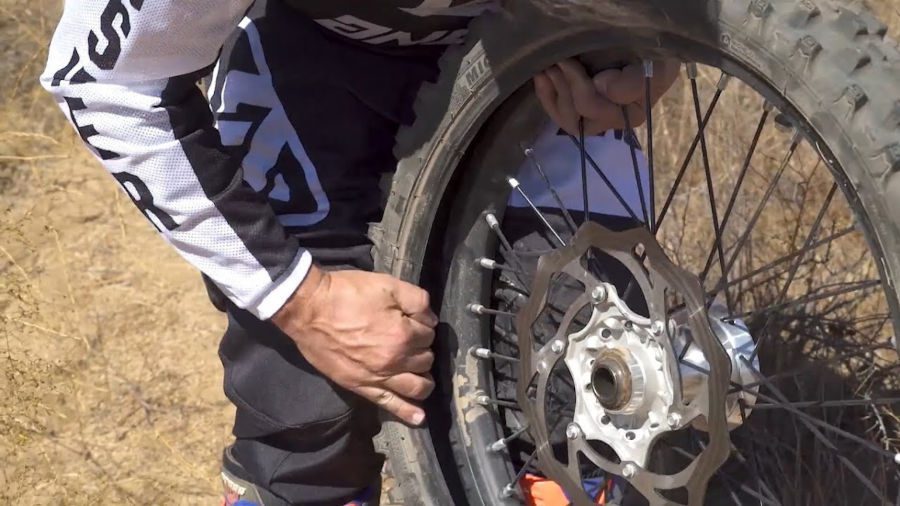
Changing a Motorbike Flat Tire On The Road
Changing a motorcycle tire is a skill every rider must perfect. Flat tires in the middle of nowhere are anticipated occurrences. Poorly installed tires could cause accidents of huge magnitudes and create horrific riding experiences.
The art of successfully changing tires on the road in case of a flat could save your life, your money and tonnes of frustration.
Not everyone enjoys riding motorbikes. However when riding a motorcycle, you should always be ready for a flat tire and act accordingly when it does happen. Your technique will vary, depending on whether the tire is tubeless or with an inner tube.
Repairing the tire would be the first option if a spare tire to replace is not available. The tire may be irreparable, so that will leave replacing as the only option.
Immediately you realize you have a flat, whether a blowout or a slow leak, maneuver your motorcycle to the side of the road. Move yourself and your motorcycle away from traffic and keep a safe distance. It is expected that your rider’s kit is well equipped with everything you need to start the procedure.
The 5 Tools You Need to Change a Motorcycle Tubeless Tire
1. A Valve Core Tool to fully deflate the tires.
2. A Bead Breaker to detach the tire from the rim.
3. Tire Irons to pry the tire loose off the bead.
4. Silicone Spray Lubricant to ease the tire off the bead.
5. A compressed air pump to inflate the new tire after installation.
A Motorcycle Jack
We may need a motorcycle jack for a large and heavy bike. This is a must for many motorbike jobs and something that is always useful.
Step One- Deflate the tire
To begin the tire removal process; you need to let all or most of the air out of the tire. It may not be necessary in case of a blowout. Depending on the structure of the valve stem, you can either screw-in or snap on it.
This makes the uninstalling of the tire much easier. You will also mark the spin direction of the wheel so that you will install the new tire in the same direction.
Step Two – Loosen the tire
Separating the wheel from the rim is the next step. You will need the bead breaker to do this. One end of the bead breaker is curved. Insert this end between the rim and tire. The bead is the curved end of the tire that meets the rim to help hold it in place.
You need to pop this loose for the tire to come away from the ream. If the bead is still too tightly attached to the rim, deflate the tire further to loosen it a bit more. Move the bead breaker all-round the circumference of the wheel until the tire is fully separated from the rim.
Step Three- Remove the tire
You may use the spray lubricant at this point; spray it on the bead so that it does not stick back onto the rim. Once you have pried the tire free on both sides then use the tire irons to separate the tire from the rim. Put the tire irons under the bead to act as a lever, and then move them around until the tire is free.
Step Four – Installing the new tire
The new tire maybe a bit stiff making it a bit difficult to handle. Spray it on the inside with the spray lubricant to make it a bit slippery. Place the new tire in the spin direction you marked earlier, it should remain the same. Take note of the small round space that the valve core should fit in and align it accordingly.
Use the tire irons to fit the new tire into the rim, this time pushing the tire right into the rim. Push the bead into the rim so that it remains tightly attached and holds the tire well in place. Once you complete one side, repeat the procedure on the other side.
Step Five- Inflate the new tire
The installation of the new tire is almost complete. Pump some air into the wheel. When you hear a little pop, this is the bead slipping into place. You may hit around it to firm up and ensure it is properly placed. If the bead is not well placed, do not keep pumping in the air. Ensure it sits well before filling up the tire.
With the installation complete, tire well filled out and rotating as it should, pour in some ceramic dust into the valve before replacing the valve stem. The ceramic dust helps in balancing the tire. Reinstall the valve stem and fully pump up the tire.
Changing a motorcycle tire inner tube
For a tire with an inner tube, the procedure is pretty much the same as outlined. The difference, after uninstalling the wheel, you will take out the damaged inner tube and either repair or replace it. Once you have it well fitted back into the tire, inflate and get back on the road.
With the inner tube, caution must be exercised not to tear the new one or damage it in the process. Check for debris or other foreign objects that may have damaged the old tube before fitting in the new one.
Repairing instead of changing the tire
In emergencies, it is not given that you will have a spare tire so other options must be explored. Repairing a wheel is a reasonable step if the damage is not extreme. Carry a puncture repair kit in your riders kit at all times. You may plug or patch the tire in case of emergencies, both simple and uncomplicated procedures.
When to change your motorcycle tires
- If you are constantly having flats, it means your tires are worn out and need replacement. Tires with too many repairs on them pose a risk to you and others as they could blowout at any time.
- If they have reached the manufacturers’ recommended mileage and tread limit. Even if the tires do not outwardly look worn out, it is best to replace them. Check the state’s recommended tread depth.
- The treads look worn out, even if they have not reached their predicted lifespan. They may wear out prematurely due to some factors, like driving in extreme terrain, being exposed to extreme weather conditions, being on the road too long, overloading, poor storage conditions, and poor maintenance.
- If the tire is seriously damaged and has visible beads, bulges, gashes and visibly worn treads, it is time to replace them.
- If the tires are wearing out unevenly and in a strange pattern, then it is time to replace them.
- If the tires feel unstable when you ride. It could be that the wrong tires were fitted onto your motorcycle at some point, which could be risky.
Replacing your tires is a skill that is developed over time. If you cannot change your tire yourself, you may call in a tire repair shop to come in and change it for you. A wrongly installed tire is a road risk and could have you in a horrific accident. Besides the looming danger, it could seriously damage your wheel and your motorcycle.
After changing your tire, it is recommended that you run through your dealer and have your tires checked. It is advisable to have your bike serviced frequently and thoroughly as recommended by your dealer. While at it, ensure they train you well on how to change your wheels.






